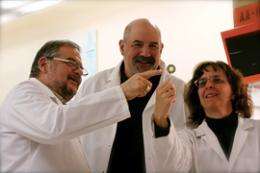Team Finds Way to Clean Up Coal, Harvest Hydrogen

(PhysOrg.com) -- The Department of Energy's (DOE) Office of Fossil Energy has awarded researchers at UT Dallas $1 million over three years to create a new class of membranes that produce hydrogen from coal while scrubbing out greenhouse gases like carbon dioxide.
Chemistry professors John Ferraris, Kenneth Balkus and Inga Musselman are creating a class of mixed-matrix membranes based on Metal-Organic Frameworks (MOFs), which are crystalline compounds with specialized metal clusters that act as molecular filters, or sieves. The filters are designed to chemically convert coal plant emissions to produce hydrogen, a crucial and emerging fuel for clean energy.
Current filters utilize palladium to separate gas emissions. Palladium, which is typically imported, is a rare, expensive metal that generates a vast amount of carbon dioxide when it is refined. The DOE charged the team with finding an alternative to palladium and improving the production of hydrogen to expand the domestic supply of clean energy.
“The combined expertise of this team is an enabling force,” said Ferraris, an organic/polymer chemist who heads the chemistry department. “Dr. Balkus is an expert in inorganic chemistry, and Dr. Musselman is an expert analytical chemist. The combination of these backgrounds allows us to synthesize new filtration membranes, to test them and to analyze their effectiveness. Few research teams can address the ‘cleaner coal challenge’ with this particular mix of chemistry expertise.”
Ferraris said the team is crafting new, custom membranes beginning with polymers that have already been identified as good gas separators. Energy production from coal releases carbon dioxide and other gasses that membranes can filter out, such as hydrogen.
“It’s difficult to separate hydrogen from carbon dioxide,” Ferraris said. “But doing so is hugely important in making coal as clean as it can be while supplying the hydrogen we need for other energy applications.”
According to Balkus, the MOFs they’re developing seek to overcome some of the limitations of other gas membranes and avoiding the cost and environmental damage of harvesting and producing the palladium.
“Imagine a helium balloon, the morning after you bring it home,” Balkus said. “The balloon remains inflated, but it sinks to the ground because some of the helium has diffused out. This is an example of one particular gas diffusing through the pores in the balloon’s surface. Our membranes will function in the same way, but they have to be efficient, cost-effective and flexible and they must endure the extreme temperatures and pressures found in coal plants.”
Musselman said the membranes in development are a mixture of polymer and MOF compounds, rather than a sandwich of membrane layers. The advantage to using a mixture, instead of layers, is that the sieves perform more efficiently and predictably across their entire surface.
“We’re trying to develop uniform membranes with very specific properties,” Musselman said. “We’re using a specialized acoustic mixer to uniformly distribute the materials in our membranes.”
The team, which students have dubbed the “FBI” (for Ferraris, Balkus and Inga), has collaborated for more than 16 years of continuously funded research aimed at using chemistry to clean up coal. This past year, in addition to the $1 million grant, they were awarded $300,000 from the DOE - University Coal Research Program and $300,000 from the National Science Foundation for other separation projects.
“Wind, solar and other renewable energy sources are the future,” Ferraris said. “But it will be decades before those energy sources replace coal. If we’re successful, current coal plants could be retrofitted with our cleaner technology.”
Provided by University of Texas at Dallas


















